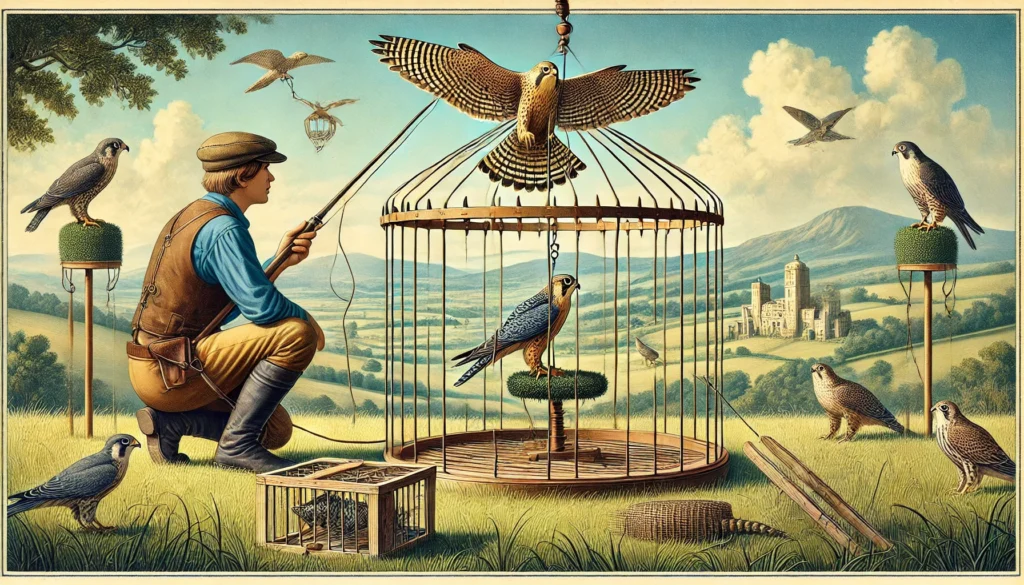Benefits of Falconry for Pest Control
- Natural Method: Falconry uses birds of prey, like falcons and hawks, to scare away unwanted pests without the use of chemicals.
- Effective Deterrent: Birds of prey are a natural predator to many pest species, making them an effective method to reduce pest populations.
- Environmentally Friendly: Since falconry avoids pesticides, it helps protect the environment and other wildlife.
- Long-term Solution: Falcons and hawks can make pests feel unsafe, encouraging them to relocate permanently.
- Versatile Usage: Falconry is adaptable and can be used in various settings such as farms, airports, and urban areas.
- Cost-Effective: Reducing pest issues through falconry can save money in the long run by lowering the expenses related to pest damages.
- Sustainable Practice: Falconry supports the conservation of birds of prey while providing an organic pest control solution.
- Enhances Safety: By reducing bird populations around airports, falconry helps prevent bird strikes, increasing aviation safety.
Learn more about how falconry can naturally and effectively manage pests at Learn Falconry!
Falconry for Pest Control: A Timeless Solution for Modern Problems
Imagine you’re sitting in a cozy Irish pub, enjoying a lively conversation with friends. Suddenly, a mischievous leprechaun sneaks in and starts causing all kinds of trouble, knocking over drinks and generally wreaking havoc. Now, wouldn’t it be great if you could call upon a wise, noble falcon to gently shoo the leprechaun away and restore peace to your evening? Well, in the world of pest control, that’s exactly what expert falconers do’minus the leprechaun, of course!
In this article, we’ll delve into the fascinating world of falconry for pest control’exploring how these magnificent birds can help you maintain a pest-free space with minimal fuss. Stick with us to discover why falconry isn’t just a relic of the past, but a valuable tool for today’s pest control challenges! So, grab a cup of tea and get comfortable; you’re in for an enlightening read that might just make you see falcons in a whole new light.
Falconry for Pest Control: An Ancient Technique with Modern Benefits
Pest control falconry is an incredible method that has been used for hundreds of years. It combines the natural hunting instincts of birds of prey with human guidance to control pest populations. But how does it work, and why is it still so effective today?
What is Pest Control Falconry?
Pest control falconry uses trained birds of prey, such as falcons, hawks, and eagles, to deter or remove pest animals like rodents, birds, and other small creatures. These majestic birds are trained to scare away or capture pests, making it an environmentally friendly and sustainable pest control method.
Learn about the history of falconry to understand how these skills have evolved over centuries.
The Benefits of Falconry for Pests
Falconry for pests offers unique advantages:
- Eco-Friendly: This method doesn’t involve chemicals or traps, making it safe for the environment.
- Effective: Birds of prey are natural predators, and their presence alone can be enough to deter pests.
- Versatile: Falconry can be used in various settings, from urban areas to agricultural fields.
To delve deeper into how falconers train these birds, visit our section on training a falcon.
Falconry Pest Techniques
This practice isn’t just about letting the birds loose. Falconers use specific falconry pest techniques to maximize efficiency:
- Free-Flying: This involves allowing the bird to fly freely around a designated area to scare off pests.
- Lure Flying: This technique uses lures to train and direct the falcons, which helps in guiding the birds effectively.
- Stationary Flying: Birds are positioned on a perch to create a presence that deters pests from entering the area.
Explore more advanced falconry techniques to understand the different methods used in pest control.
Training Birds for Pest Control
Training a bird for pest control is a detailed process that requires patience and expertise. Here are some key steps involved:
- Basic Training Techniques: Initially, young falcons learn to obey commands and build a bond with their handler.
- Advanced Training Methods: Techniques like recall training and conditioning improve the bird’s hunting and deterrence skills.
Further information on basic and advanced training can be found in our detailed guides on training a falcon.
Best Birds for Pest Control
Different species of falcons are used based on their characteristics. Some of the most effective birds for pest control include:
- Peregrine Falcons: Known for their speed and agility, making them perfect for scaring away birds.
- Harris’s Hawks: Popular for their adaptability and cooperative hunting skills.
- Gyrfalcons: Their strength and size make them excellent for larger pests.
Learn about various species of falcons to choose the best bird for your needs.
Ethical Considerations and Legal Aspects
Using falconry for pest control also involves understanding the ethical and legal dimensions:
- Ethical Falconry: Ensures that the birds are well cared for and their presence doesn’t disrupt local wildlife.
- Legal Regulations: Falconers need to follow specific laws and obtain permits.
For more on ethical practices and legal requirements, check out our sections on ethical falconry and legal aspects of falconry.
Falconry Equipment for Pest Control
To practice pest control falconry, specialized equipment is essential:
- Hoods and Jesses: Used for controlling and calming the birds.
- Telemetry: For tracking birds if they fly out of sight.
- Gloves and Lures: Essential for handling and training.
Explore different types of falconry equipment required for pest control.
Falconry for pest control is not just a historic practice; it’s a modern solution rooted in tradition and innovation. Delve deeper into the fascinating world of falconry and discover how this ancient art continues to be relevant today.
The Eco-Friendly Solution: Falconry for Pest Control
Falconry is a unique and natural method for controlling pest birds. By using trained birds of prey to scare away nuisance species, this technique offers a compelling alternative to traditional pest control methods. Here, we’ll dive into how falconry works for pest control, its benefits, and the techniques involved.
How Falconry for Pest Control Works
Using trained birds of prey, such as falcons and Harris’s hawks, falconry capitalizes on the natural predator-prey relationship to deter pest birds from specific areas. The presence of these birds is often enough to scare away pests, as they instinctively recognize the threat.
| Aspect | Description |
|---|---|
| Bird Species | Falcons and Harris’s hawks are commonly used. |
| Training | Birds undergo a process called “manning,” which includes taming and acclimating them to various environments and stimuli. |
| Program Structure | Regular site visits, usually up to three times a week, with each session lasting at least two hours. |
| Supplementary Techniques | Egg and nest removal to prevent aggressive behavior and population growth, especially crucial for species like gulls. |
Effectiveness of Falconry
Falconry is not just a fascinating method; it is also highly effective. In vineyards, for example, falconry can save up to 15% of the crop that would otherwise be lost to pest birds.
| Environment | Benefits of Falconry |
|---|---|
| Vineyards | Saves up to 15% of crops by deterring pest birds naturally. |
| City Centers | Reduces pigeon populations without harming the birds. |
| Industrial Areas | Prevents damage to machinery and property from bird nests. |
Advantages Over Traditional Methods
One of the primary reasons for the growing popularity of falconry in pest control is its eco-friendliness. Unlike conventional methods, falconry doesn’t involve the use of harmful chemicals or traps, making it a sustainable and humane option.
Environmental Benefits:
- Chemical-Free: Eliminates the need for pesticides and other harmful chemicals.
- No Harm to Non-Target Species: Only deters the specific pest species without affecting other wildlife.
- Natural Deterrent: Utilizes the natural predator-prey relationship to control pest populations.
Integration with Other Pest Control Methods
Falconry can be seamlessly combined with other pest control techniques to enhance its effectiveness. For example, incorporating nest boxes and insectivorous birds can create a multifaceted approach to controlling pests.
| Integrated Method | Description |
|---|---|
| Nest Boxes | Houses for natural predators like owls, which can also help control rodent population. |
| Egg and Nest Removal | Regular removal of eggs and nests to reduce pest bird reproduction, particularly useful in the breeding season. |
Cost and Regulatory Considerations
While falconry is effective and eco-friendly, it does come with costs. The expenses of hiring a professional falconer and maintaining a falconry program can be significant, making it a more viable option for larger establishments with substantial pest problems.
In addition, falconry is regulated by state and federal authorities to ensure the welfare of both the birds of prey and the areas they operate in. Licensed or permitted falconers must comply with stringent guidelines.
Risk Assessment and Monitoring
To ensure the success and safety of falconry programs, thorough risk assessments and continuous monitoring are essential. This involves:
- Risk Assessments: Detailed evaluations to identify potential hazards and ensure safety.
- Monitoring Nest Sites: Tracking the success of falconry programs and ensuring the birds’ health and effectiveness.
In summary, falconry for pest control is an innovative, eco-friendly method that uses the natural instincts of birds of prey to manage pest bird populations effectively. It’s not only fascinating to witness but also contributes to a more sustainable approach to pest management.
The Power of Falconry for Natural Pest Control
Falconry stands out as an incredibly effective and humane method for controlling pest birds. By leveraging the natural instincts and prowess of birds of prey like Harris’s Hawks and Peregrine Falcons, falconry offers an eco-friendly, chemical-free alternative that benefits our environment. Trained birds are flown over problem areas, causing pest birds to disperse and reducing crop losses significantly.
These majestic raptors are specially trained to safely interact with their handlers and adapt to various environments, allowing for efficient pest control in both indoor and outdoor settings. Regular site visits and supplementary practices like egg and nest removal ensure sustained effectiveness.
Not only does this method protect our crops and properties, but it also promotes a harmonious balance with nature, showcasing the fascinating bond between humans and these powerful birds. By choosing falconry, you’re investing in a sustainable, respectful, and profoundly effective solution to pest management.



